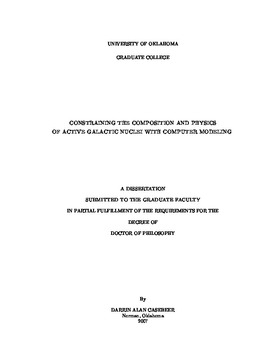| dc.contributor.advisor | Leighly, Karen M., | en_US |
| dc.contributor.author | Casebeer, Darrin Alan. | en_US |
| dc.date.accessioned | 2013-08-16T12:20:37Z | |
| dc.date.available | 2013-08-16T12:20:37Z | |
| dc.date.issued | 2007 | en_US |
| dc.identifier.uri | https://hdl.handle.net/11244/1175 | |
| dc.description.abstract | We present analysis from simultaneous FUSE, ASCA, and EUVE observations, as well as a reanalysis of archival HST spectra, from the extreme Narrow-line Seyfert 1 Galaxy RE 1034+39 (KUG 1031+398). RE 1034+39 has an unusually hard spectral energy distribution (SED) that peaks in the soft X-rays. Its emission lines are unusual in that they can all be modelled as a Lorentzian centered at the rest wavelength with only a small range in velocity widths. In order to investigate whether the unusual SED influences the emission line ratios and equivalent widths, we present three complementary types of photoionization analysis. The FUSE spectrum was particularly important because it includes the highionization line O VI. First, we use the photoionization code Cloudy and the SED developed from the coordinated observations to confirm that the emission lines are consistent with the observed hard SED. The best model parameters were an ionization parameter log(U) ≈ -2 and a hydrogen number density log(nH) = 9.75 [cm -2]. Second, we present a Locally Optimally-emitting Cloud model. This model produced enhanced O VI as observed, but also yielded far too strong Mg II. Third, we develop a series of semi-empirical SEDs, run Cloudy models, and compare the results with the measured values using a figure of merit (FOM). The FOM minimum indicates similar SED and gas properties as were inferred from the one-zone model using the RE 1034+39 continuum. Furthermore, the FOM increases sharply toward softer continua, indicating that a hard SED is required by the data in the context of a one-zone model. | en_US |
| dc.description.abstract | The following dissertation consists of a report of the main body of work that I have completed as a graduate student. | en_US |
| dc.description.abstract | We present detailed radiative transfer spectral synthesis models for the Iron Low Ionization Broad Absorption Line (FeLoBAL) active galactic nuclei (AGN) FIRST J121442.3+280329 and ISO J005645.1-273816. Detailed NLTE spectral synthesis with a spherically symmetric outflow reproduces the observed spectra very well across a large wavelength range. While exact spherical symmetry is probably not required, our model fits are compelling and thus very large covering fractions are strongly implied by our results. We constrain the kinetic energy and mass in the ejecta and discuss their implications on the accretion rate. Our results support the idea that FeLoBALs may be an evolutionary stage in the development of more ''ordinary'' QSOs. | en_US |
| dc.format.extent | xii, 128 leaves : | en_US |
| dc.subject | Active galactic nuclei. | en_US |
| dc.subject | Spectral energy distribution. | en_US |
| dc.subject | Photoionization. | en_US |
| dc.subject | Physics, Astronomy and Astrophysics. | en_US |
| dc.title | Constraining the composition and physics of active galactic nuclei with computer modeling. | en_US |
| dc.type | Thesis | en_US |
| dc.thesis.degree | Ph.D. | en_US |
| dc.thesis.degreeDiscipline | Homer L. Dodge Department of Physics and Astronomy | en_US |
| dc.note | Source: Dissertation Abstracts International, Volume: 68-04, Section: B, page: 2404. | en_US |
| dc.note | Adviser: Karen M. Leighly. | en_US |
| ou.identifier | (UMI)AAI3261098 | en_US |
| ou.group | College of Arts and Sciences::Homer L. Dodge Department of Physics and Astronomy | |
